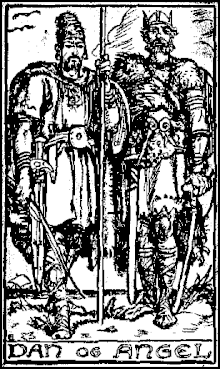Dan (king)
This article needs additional citations for verification. (January 2019) |
Dan (or
The Lejre Chronicle
The Chronicle of Lejre (
The Rígsthula
The Eddic poem Rígsthula,
The Skjöldungasaga
According to
Ríg (Rigus) was a man not the least among the great ones of his time. He married the daughter of a certain Danp [Old Norse Danpr], lord of Danpsted, whose name was Dana; and later, having won the royal title for his province, left as his heir his son by Dana, called Dan or Danum, all of whose subjects were called Danes.
This tradition is close to that of the Rígsthula.
This Dan married Olof the daughter of Wermund and so became brother-in-law to the Offa of Angel mentioned in the Old English poem Beowulf. Dan ruled first in Jutland but then conquered Zealand from King Aleif creating the kingdom of Denmark.
Ynglinga saga
Dygviwas the first of his family to be called konungr, for his predecessors had been called dróttinn ['chieftain'], and their wives dróttning, and their court drótt ['war band']. Each of their race was called Yngvi, or Ynguni, and the whole race together Ynglingar. Queen Drótt was a sister of King Dan Mikilláti, from whom Denmark took its name.
Here Ríg is the father of Danp, the father of Dan. The title Mikilláti can be translated 'Magnificent' or 'Proud'.
Snorri does not relate here whether this Dan is also descended from King
In the time when the kings we have been speaking of were in Uppsala, Denmark had been ruled over by Dan Mikilláti, who lived to a very great age; then by his son, Fróði Mikilláti, or the Peace-loving, who was succeeded by his sons
Halfdanand Fridleif, who were great warriors.
This peaceful Fróði seems a duplicate of the earlier Fróði.
In his preface to the Heimskringla (which includes the Ynglinga saga), Snorri writes:
The Age of Cairns began properly in Denmark after Dan Mikilláti had raised for himself a burial cairn, and ordered that he should be buried in it on his death, with his royal ornaments and armour, his horse and saddle-furniture, and other valuable goods; and many of his descendants followed his example. But the burning of the dead continued, long after that time, to be the custom of the Swedes and Northmen.
Sven Aagesen
The 12th century
The Gesta Danorum

Saxo Grammaticus in his Gesta Danorum presents three different Danish monarchs named Dan, either splitting up a single monarch into many or properly keeping separate what others have confused.
Saxo begins his history with two brothers named Dan and Angul, sons of one Humbli, who were made rulers by the consent of the people because of their bravery. They were not however called "kings", as that usage was not then common.
Angul is the eponym of the region of
Neither one is otherwise known, though a king named
The second king called Dan appears much later in Book 4, as the son of Uffi son of Vermund, (that is Offa of Angel son of Wermund). But Saxo passes over him in a few lines as a warlike king who scorned his subjects and wasted his wealth, much degenerated from his ancestors.
He is followed by King Huglek, then Fróði the Active, who is then followed by the third Dan. Saxo does not specifically give the parentage of any of these kings. Of this Dan, Saxo relates only an anecdote that when Dan was twelve years old, tired of the arrogance of Saxon ambassadors who demanded tribute on pain of war, he bridged the river Elbe with ships, crossed over, and won a great victory.
This Dan is the father of Fridlef father of Frothi, in whom one recognizes Fridleif and his son Fróði mentioned often in Norse sources, the latter being, at least by parentage, the Peace-Fróði whom Snorri introduced in the early in the Ynglinga saga.
The Song of Eric
The "
The ballad deals with Eric, the first king of
The song was first published in a Latin translation in
See also
- Dan I of Denmark
- Angul
